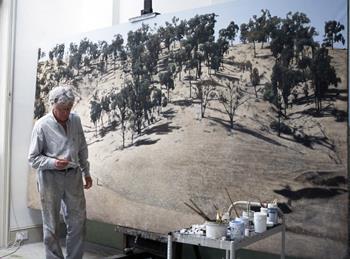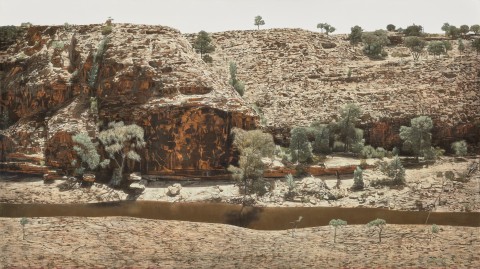MOOTWINGEE, 1990
WILLIAM DELAFIELD COOK
synthetic polymer paint on linen
110.0 x 197.0 cm
signed and dated lower right: Delafield Cook 90
Australian Galleries, Melbourne (label attached verso)
Tolarno Galleries, Melbourne (label attached verso)
The National Australia Bank Art Collection, acquired from the above in September 1990 (label attached verso)
National Australia Bank Collection: Rivers in Australian Art, Heide Park and Art Gallery, Melbourne, October 1991
Australian Art: Colonial to Contemporary, Deutscher Fine Art, Melbourne, May – June 1995, cat. 110 (illus. in exhibition catalogue, p. 83)
The National Australia Bank Art Collection: Rivers in Australian Art, Heide Park and Art Gallery, Melbourne, 1991, p. 15 (illus.)
Hart, D., William Delafield Cook, Craftsman House, Sydney, 1998, pl. 100, pp. 190, 197 (illus.)
210728 - William Delafield Cook in his studio.jpg

‘On one level my work might be seen as about some kind of reassuring, comfortable landscape painting – a banal thing… I’ve never felt that reassured. I’ve always felt the whole thing of our human existence is very precarious. The landscape is part of our time span here; it asks all the big questions because there is this whole mystery about reality out there and our mortality.’1
Hailed the quiet hero of Australian art, William Delafield Cook is one of those rare few artists whose works have entered public and private collections almost as soon as the final brushstroke has dried. Whether immortalising a carefully constructed pyramid of haystacks, the subtle nuances of the intractable Australian bush, or ancient relics in one of Europe’s hallowed art museums, undoubtedly fundamental to the widespread appeal of Cook’s art has been his unique ability to produce tantalisingly real images of meticulous, near photographic exactitude. Imbued with a haunting air of stillness, his immaculate images betray not only a fascination with the illusory possibilities of paint and mankind’s attempt to civilise nature however. More importantly perhaps, they explore the artist’s deeply felt awareness of our own mortality – a sense of time as immeasurable against the acute poignancy of our short lives. As he astutely mused, ‘I’ve long seen the world as a series of theatre stages. We players move in and out, but the world endures long beyond us.’2
With their glacial proportions and timeless subject matter, Delafield Cook’s Australian landscapes such as the magnificent Mootwingee, 1990, eloquently capture this concept of time immemorial. For despite their visual immediacy and apparent fidelity, such landscapes nevertheless appear suspended in time – suffused with a sense of calm and tranquillity that, though reassuring in its contemplation of an eternal space, simultaneously evokes a disquieting undercurrent of anxiety and uncertainty through the landscape’s ability to expose our limits and the finitude of our existence.3 The span of a human life pales into insignificance in the face of such an ancient and monumental rock formation; and indeed, as the artist admits, part of his motivation for fastidiously recording a place springs from ‘acknowledging your mortality’ and ‘attempting to leave something behind after you are gone.’4 Heightening the depiction of reality to such unimaginable degree to reveal the ‘essence’ of his subjects, thus Delafield Cook highlights the surreal within the real, inviting us to contemplate that which lies beyond our perception – the basic human quest for an underlying universal truth that transcends time or locality.
Both Delafield Cook’s affinity for the Australian landscape and his consummate skill in capturing its essential character with an intensity that is unparalleled in Australian art is all the more remarkable when one considers that such paintings – which he created almost exclusively from the late 1970s onwards – were produced entirely from his studio in London. Relocating to London in 1958 after what had been intended as a short trip became a second home, significantly Delafield Cook would nevertheless spend part of every year for the last three decades of his life travelling back to his country of origin to reconnect and undertake long journeys into the landscape ‘…where his ancestors had settled, where his grandfather had painted, where he had grown up…’5, before then returning to his studio abroad to recreate his vision. Paradoxically perhaps, such distance has only enhanced the power of his iconic landscapes, allowing the artist to pursue ‘…the pure idea of land filtered through memory, in which all voices and activities are silenced, and the spirit of the earth can peacefully emerge’6. As he reflects, ‘My feeling about the process of removing oneself at intervals from direct contact with the source of one’s subject matter is that distancing intensifies the experience of the place, makes it in recollection more vivid. By squirrelling it away, then retrieving it at a later date you can recover it, repossess it, see what it is that should happen to it.’7
Paying homage to the breathtaking ancient landscape of Mutawintji (or Mootwingee) National Park, 130 kilometres to the north-east of Broken Hill in New South Wales, Mootwingee was inspired by the artist’s travels in the area after he was invited by the Director of the Broken Hill Art Gallery at the time, Michael Pursche, to present a lecture in November 1986. Derived from the Aboriginal word meaning ‘green grass’, Mootwingee holds dual significance in both traditional indigenous culture and the history of nineteenth-century white exploration; as elucidated by Alan Moorehead in his moving recount, Cooper’s Creek (1963): ‘Even today it’s an extraordinary place, for there is much evidence here of the existence of an inland sea in prehistoric times; marine fossils are found, and the conglomerate rock is filled with pebbles that appear to have been formed by the action of rough waves… For the blacks this was a sacred place. They came here for their circumcision rites and other tribal ceremonies and in the over-hanging caves they made drawings and rock carvings.’8
For Delafield Cook, moreover, the site bore particular resonance derived from his interest in the work of Ludwig Becker, an artist and naturalist who had accompanied Burke and Wills on their arduous, ill-fated expedition in search of a mythical inland sea in 1860. As illuminated by the artist – and relayed by art dealer and consultant, Georges Mora, in his letter to then-Chairman of the National Australia Bank, Sir Rupert Clarke, in June 1990 – ‘This (Mottwingee [sic.]) interested me as the place where Bourke [sic.] and Wills stopped en route to the centre and where their artist Ludwig Becker did at least two versions of the same subject: one in watercolours, the other, I think, a pen and ink drawing… I made the trip as part of an overall project I had some years ago to re-visit places that artists have been interested in – lots of Von Guerard of course – The Becker things are especially poignant in that he did not survive very long after doing these drawings…’9 A powerful, mysterious image, Mootwingee offers a recreation of this sacred landscape that is so utterly still and elemental, it seems beyond time. Notwithstanding its ostensible neutrality or stark emptiness, the landscape is informed rather by exquisitely rendered incidents – both small and large, including rocks, stone, branches, tracks – while the vast amplitude of the excavated rockface is conveyed through the painting’s panoramic scale; as Delafield Cook suggests, ‘…it brings in this element of having to turn your head to take in the picture which fills the field of vision, like being there.’10
Infinite in its detail and infinite in its expanse, Mootwingee thus fathoms an Australian ‘sublime’ that is boundless and majestic in the manner of David Casper Friedrich and the eighteenth-century Romantics Delafield Cook so admired. Inspiring awe and reverence, the classical harmony and stillness of the work implies that the forces of the cosmos have here aligned – that there is a divine order amidst the chaos of nature.11 Bereft of human presence or any apparent narrative, it is the landscape itself, distilled in its unknowable ‘essence’, that occupies centre stage, imbued with a sense of drama that leaves the viewer poised indefinitely in a moment of suspense. As Delafield Cook observes of this quality in his art, ‘It’s the stage that we’re living out our lives in… The picture is the set, pregnant with possibilities’.12
1. The artist, cited in Hart, D., William Delafeld Cook, Craftsman House, Sydney, 1998, p. 203
2. The artist, cited in Field, F., ‘William Delafield Cook: Artist hailed as one of Australia’s finest whose monumental canvases depicted the rugged landscape of his native land’, The Independent, London, 13 May 2015
3. Fitzpatrick, A., ‘Intimations of Mortality in the Work of William Delafield Cook’ in William Delafield Cook. A Survey, Gippsland Art Gallery, Sale, 2011, pp.32 – 44, p.39
4. The artist, cited in Hart, op. cit., p. 184
5. Hart, ibid., p. 168
6. Gregg, S., ‘William Delafield Cook: A Survey’, in William Delafield Cook. A Survey, Gippsland Art Gallery, Sale, 2011, pp. 2 – 23, p.5
7. The artist, cited ibid.
8. Moorehead, A., Cooper’s Creek, Hamish Hamilton, London, 1963, p. 60
9. The artist, cited in Letter from Georges Mora to Sir Rupert Clarke, 20 June 1990, NAB Archives
10. The artist, cited in Hart, op. cit., p. 199
11. Gregg, op. cit., p.9
12. The artist, cited ibid. p.16
VERONICA ANGELATOS
